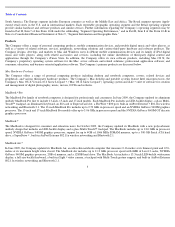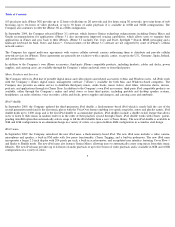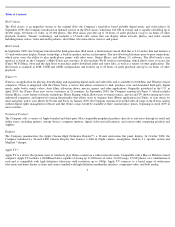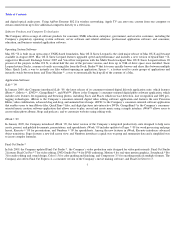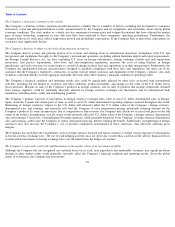Apple 2009 Annual Report Download - page 15
Download and view the complete annual report
Please find page 15 of the 2009 Apple annual report below. You can navigate through the pages in the report by either clicking on the pages listed below, or by using the keyword search tool below to find specific information within the annual report.
Table of Contents
Foreign and Domestic Operations and Geographic Data
The U.S. represents the Company’s largest geographic marketplace. Approximately 54% of the Company’
s net sales in 2009 came from sales to
customers inside the U.S. Final assembly of the Company’s products is currently performed in the Company’
s manufacturing facility in Ireland,
and by external vendors in California, Texas, the People’s Republic of China (“China”),
the Czech Republic and the Republic of Korea
(“Korea”). Currently, the supply and manufacture of many critical components is performed by sole-sourced third-
party vendors in the U.S.,
China, Germany, Ireland, Israel, Japan, Korea, Malaysia, the Netherlands, the Philippines, Taiwan, Thailand and Singapore. Sole-sourced third-
party vendors in China perform final assembly of substantially all of the Company’
s portable Mac products, iPhone, iPods and most of the
Company’s desktop products. Margins on sales of the Company’
s products in foreign countries, and on sales of products that include
components obtained from foreign suppliers, can be adversely affected by foreign currency exchange rate fluctuations and by international trade
regulations, including tariffs and antidumping penalties.
Information regarding financial data by geographic segment is set forth in Part II, Item 7 and Item 8 of this Form 10-
K and in Notes to
Consolidated Financial Statements at Note 9, “Segment Information and Geographic Data.”
Seasonal Business
The Company has historically experienced increased net sales in its first and fourth fiscal quarters compared to other quarters in its fiscal year
due to seasonal demand related to the holiday season and the beginning of the school year. This historical pattern should not be considered a
reliable indicator of the Company’s future net sales or financial performance.
Warranty
The Company offers a basic limited parts and labor warranty on most of its hardware products, including Mac computers, iPhones and iPods.
The basic warranty period is typically one year from the date of purchase by the original end-user. The Company also offers a 90-
day basic
warranty for its service parts used to repair the Company’
s hardware products. In addition, consumers may purchase the AppleCare Protection
Plan, which extends service coverage on many of the Company’s hardware products in most of its major markets.
Backlog
In the Company’
s experience, the actual amount of product backlog at any particular time is not a meaningful indication of its future business
prospects. In particular, backlog often increases in anticipation of or immediately following new product introductions as dealers anticipate
shortages. Backlog is often reduced once dealers and customers believe they can obtain sufficient supply. Because of the foregoing, backlog
should not be considered a reliable indicator of the Company’s ability to achieve any particular level of revenue or financial performance.
Environmental Laws
Compliance with federal, state, local and foreign laws enacted for the protection of the environment has to date had no material effect on the
Company’
s capital expenditures, earnings, or competitive position. In the future, compliance with environmental laws could materially adversely
affect the Company.
Production and marketing of products in certain states and countries may subject the Company to environmental and other regulations including,
in some instances, the requirement to provide customers the ability to return product at the end of its useful life, and place responsibility for
environmentally safe disposal or recycling with the Company. Such laws and regulations have been passed in several jurisdictions in which the
Company operates including various countries within Europe and Asia and certain states and provinces within North America. Although the
Company does not anticipate any material adverse effects in the future based on the nature of its operations and the thrust of such laws, there is
no assurance that such existing laws or future laws will not materially adversely affect the Company’s financial condition or operating results.
12



